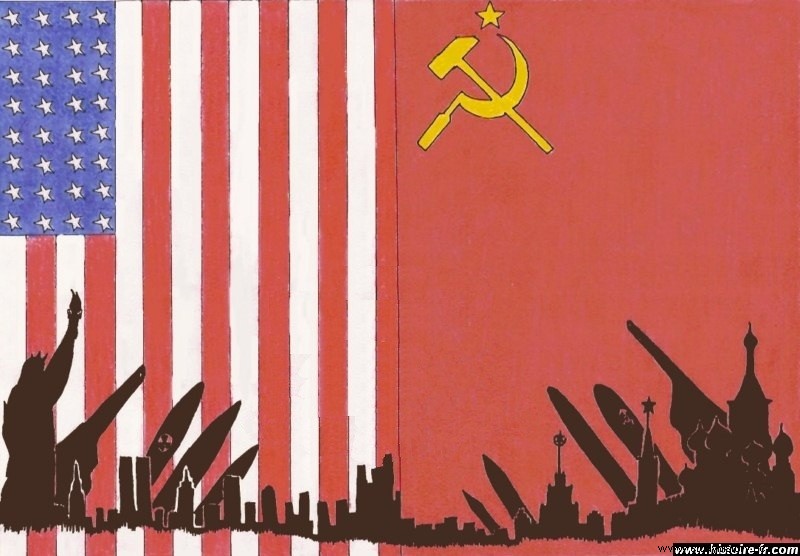 Summary:It is referred to as the Cold War the period of strong tensions between 1947 and 1991 between the United States (and its Western allies) and the Eastern bloc headed by the USSR. A legacy of the Second World War, this confrontation will only be tempered by the threat of nuclear weapons. Very conflictual economic and diplomatic relations between the two superpowers, a climate of growing suspicion and hostility, a race for both conventional and nuclear armaments which quickly leads to a balance of terror, as well as the multiplication of local conflicts where ideological confrontation works by interposed allied countries, etc., these are the components of the Cold War. The collapse of the communist world from 1989 gave way to a new world order (or disorder) and saw the emergence of new threats.
Summary:It is referred to as the Cold War the period of strong tensions between 1947 and 1991 between the United States (and its Western allies) and the Eastern bloc headed by the USSR. A legacy of the Second World War, this confrontation will only be tempered by the threat of nuclear weapons. Very conflictual economic and diplomatic relations between the two superpowers, a climate of growing suspicion and hostility, a race for both conventional and nuclear armaments which quickly leads to a balance of terror, as well as the multiplication of local conflicts where ideological confrontation works by interposed allied countries, etc., these are the components of the Cold War. The collapse of the communist world from 1989 gave way to a new world order (or disorder) and saw the emergence of new threats.
The beginnings of the Cold War
While the Second World War was not yet over, the future victors discussed as early as 1943 the new world order that would emerge from the end of the conflict, and the zones of everyone's influence. It was at the Yalta conference in February 1945 that the contours of the post-war world were drawn. Defeated Germany was divided into four occupation zones under Soviet, American, French and British control, a pattern reproduced in its own capital, Berlin. In Eastern Europe and despite Stalin's commitments, elected governments are gradually being replaced by pro-Soviet regimes.
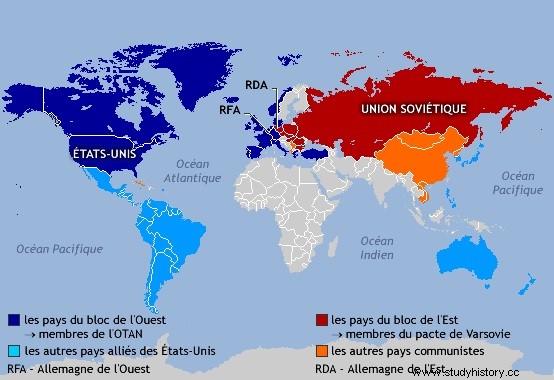 On March 5, 1946, in Fulton in the United States, Winston Churchill gave a famous speech in which he used the he expression “iron curtain”, an expression that immediately became symbolic of the world's entry into the Cold War:“From Stettin on the Baltic to Trieste on the Adriatic, an iron curtain has fallen and is dividing the continent. Behind this line are all the capitals of the former states of Central and Eastern Europe... subject... to Soviet influence.” The former Prime Minister immediately pleaded for a new alliance between Western democracies to counter Soviet expansionism.
On March 5, 1946, in Fulton in the United States, Winston Churchill gave a famous speech in which he used the he expression “iron curtain”, an expression that immediately became symbolic of the world's entry into the Cold War:“From Stettin on the Baltic to Trieste on the Adriatic, an iron curtain has fallen and is dividing the continent. Behind this line are all the capitals of the former states of Central and Eastern Europe... subject... to Soviet influence.” The former Prime Minister immediately pleaded for a new alliance between Western democracies to counter Soviet expansionism.
This need became all the more pressing when two years later, in 1948, the Soviets tried to drive the other forces present out of West Berlin by isolating their sector. Only a vast supply airlift organized by the Western camp can save West Berlin from starvation. In 1949, Germany was divided into two distinct countries. In the same year, the Soviet Union developed its own atomic bomb and was now in a position to compete with the United States.
To stem Soviet influence and in accordance with the Truman Doctrine , the United States set up the Marshall Plan, which aims to accelerate the reconstruction of Europe, and deployed significant forces in Germany. In 1949, they formed with Canada and ten Western European countries (14 later) a defensive military alliance, NATO (North Atlantic Treaty Organization). Following the accession of West Germany (FRG) to this organization in 1955, the Soviet Union responded by creating the Warsaw Pact, a military bloc that included the popular democracies of Eastern Europe.
The Balance of Terror
The United States and the Soviet Union then embarked on a frantic race to develop thermonuclear (hydrogen) bombs, with a destructive power many times greater than that of fission bombs. With this type of weapon and the rapid development of missile launching systems, it became possible in the course of all-out war to wipe out all life on earth several times over. The two superpowers are increasing their stock of nuclear weapons tenfold to maintain the guarantee of mutually assured destruction (M.A.D) in the event of a conflict, and thus dissuade the opposing camp from resorting to the bomb first.
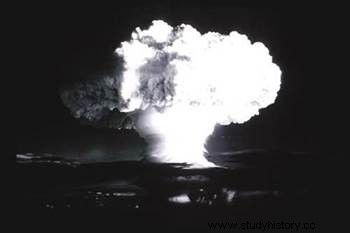 The Korean War, born out of North Korea's invasion of South Korea, took, in the context of the Cold War, the turn of a localized international war, notably involving the United States and China. Contrary to the fears it may have provoked at first, it did not lead to a Third World War because of the desire of the United States and the Soviet Union not to engage in a confrontation. face-to-face.
The Korean War, born out of North Korea's invasion of South Korea, took, in the context of the Cold War, the turn of a localized international war, notably involving the United States and China. Contrary to the fears it may have provoked at first, it did not lead to a Third World War because of the desire of the United States and the Soviet Union not to engage in a confrontation. face-to-face.
It was at the end of this conflict that the two antagonistic blocks put in place the principles of "peaceful coexistence". This development is facilitated by the death of Stalin and the coming to power of Nikita Khrushchev. Aware of generating a powder keg that could lead to the annihilation of the planet, the belligerents are concerned to avoid escalation and the diplomats outline a common discourse of aspiration for peace. Complete disarmament being unrealistic and impossible to control, we opt for a control policy. The International Atomic Energy Agency (I.A.E.A.) was created in 1957 to monitor the development and proliferation of nuclear technology and materials.
Between Cold War and peaceful coexistence
During the Budapest uprising (October-November 1956), it was evident that the Americans were not seeking to take advantage of the Soviet difficulties and that the peoples of Europe of the East should not count on their help to free itself from the tutelage of Moscow. At the same time, during the Suez crisis, the United States and the U.S.S.R. exerted a convergent diplomatic action to put an end to the Franco-British intervention alongside Israel. The lead taken by the Soviets in the field of space (launch of Sputnik I, Oct. 1957) contributed to a rebalancing of forces which could only hasten the dialogue between the two Great Powers. In 1958, a conference on the cessation of nuclear testing opened in Geneva. After a trip by Vice President Nixon to Moscow, Khrushchev traveled to the United States and met Eisenhower at Camp David (September 1959).
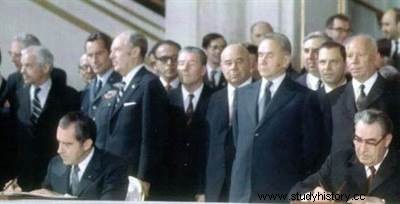 However, the summit conference in Paris (May 1960) was to fail in its first session, the Soviets coming from discovering that their territory was being spied on by high-flying American reconnaissance planes. Khrushchev, whose policy of “peaceful coexistence” was already criticized by the Chinese, tried in vain, by unleashing the new crisis in Berlin, to obtain a prestigious success which would have strengthened his position within the communist world. The construction of the Berlin Wall (August 1961) even seemed to relaunch the Cold War, but the Kremlin's desire for peace was to manifest itself the following year, when Khrushchev, in October 1962, yielded to President Kennedy's ultimatum and accepted to withdraw Soviet rockets from Cuba.
However, the summit conference in Paris (May 1960) was to fail in its first session, the Soviets coming from discovering that their territory was being spied on by high-flying American reconnaissance planes. Khrushchev, whose policy of “peaceful coexistence” was already criticized by the Chinese, tried in vain, by unleashing the new crisis in Berlin, to obtain a prestigious success which would have strengthened his position within the communist world. The construction of the Berlin Wall (August 1961) even seemed to relaunch the Cold War, but the Kremlin's desire for peace was to manifest itself the following year, when Khrushchev, in October 1962, yielded to President Kennedy's ultimatum and accepted to withdraw Soviet rockets from Cuba.
From now on, the aggravation of the ideological conflict with China would push Moscow to seek an overall settlement with the West. The Moscow agreement on the cessation of nuclear testing in the atmosphere (July 1963) marked the end of an era. The new power of China, the policy of independence pursued by General de Gaulle manifested moreover the appearance of new forces which, with the division of the world into two blocks immobilized by the "balance of terror", tended to substitute new poles of power, truly autonomous, although unable to compete with the "Great".
The relaxation and weakening of blocks
In August 1963, the United States, England and the Soviet Union concluded the Moscow Agreement, which for an indefinite period banned nuclear experiments in the atmosphere, under the sea and in space. This agreement, which entered into force on Oct. 10, 1963 and was ratified by more than a hundred States, saw its limited scope, however, because France and China, which became nuclear powers - respectively in 1963 and 1964 - refused to subscribe to it. For the French and Chinese governments, in fact, the Anglo-Saxon and Soviet agreements had the sole purpose of keeping the atomic "club" closed and safeguarding the military advance taken by the United States, England and Europe. 'U.S.S.R.; these powers did not realize the danger of explosions in the atmosphere until they had carried out at their leisure the experiments essential to the development of their nuclear panoply.
It was with the same mistrust that Paris and Beijing welcomed the nuclear non-proliferation treaty, which, called for by the U.N. General Assembly. since 1961, was signed by the United States, Great Britain and the U.S.S.R. on July 1, 1968, and subsequently ratified by a hundred States, but not by France and China. By this treaty, the nuclear powers concerned undertook not to transfer to other countries, directly or indirectly, nuclear weapons; the non-nuclear powers for their part undertook not to manufacture or acquire nuclear weapons, nor to seek or receive any aid for the manufacture of these weapons.
At the end of the 1960s, the two blocs began a process of detente in order to ease international tension and promote peaceful coexistence. Despite the rise in tension that marked the crushing of the Prague Spring in Czechoslovakia by Warsaw Pact troops in 1968, negotiations followed that led to the SALT agreements (Conference on the Limitation of Strategic Arms). What indeed gives all its strength to detente and which constitutes at the same time its main motivation is the effort to reduce military competition and in particular the danger of nuclear war.
 The first half of the 1970s marked the peak of détente, as evidenced by the evolution of the situation in Europe. Relations between West Germany and its Polish and German neighbors to the East, as well as with the Soviets, are normalized. President Richard Nixon went to Moscow in 1972 and received Leonid Brezhnev in Washington the following year. Finally, the Helsinki agreements signed by 35 European countries recognize the existing borders, provide for the strengthening of respect for human rights as well as technical cooperation between East and West.
The first half of the 1970s marked the peak of détente, as evidenced by the evolution of the situation in Europe. Relations between West Germany and its Polish and German neighbors to the East, as well as with the Soviets, are normalized. President Richard Nixon went to Moscow in 1972 and received Leonid Brezhnev in Washington the following year. Finally, the Helsinki agreements signed by 35 European countries recognize the existing borders, provide for the strengthening of respect for human rights as well as technical cooperation between East and West.
But, an ephemeral state which in reality does not induce any structural change to the division of the world into two blocks, detente is at the mercy of the slightest change in politics of the two big ones. Thus, the resumption of the expansionist line by the Soviets in the mid-1970s and the election of Ronald Reagan as President of the United States marked the return of tension between the two blocs.
The end of the Cold War
The arms race resumed with renewed vigor:in 1977, the USSR installed missiles in Eastern Europe aimed at Western Europe; in response, US President Ronald Reagan in turn deploys weapons from 1980. This is the euromissile crisis. In 1979, international relations were severed when the Soviets invaded Afghanistan. This is the beginning of an endless and terrible war that will be compared to the Vietnam War for the Americans, the latter providing massive support to the Afghan resistance.
In March 1983, President Ronald Reagan announced the launch of a vast American military research program, known as “Star Wars”, which called into question the doctrine of the balance of terror. The Strategic Defense Initiative aimed to develop a system capable of intercepting and destroying enemy strategic ballistic missiles before they reached the soil of the United States or that of its allies. This revival of the arms race, involving huge investments in research and development, was accompanied by a new policy of firmness by the West against the Soviets. More or less realistic and achievable, this project above all highlights the inability of the USSR to pursue technological competition in the field of armaments in the long term.
The dialogue resumes with the coming to power in the USSR of the reformer Mikhail Gorbachev, after the death of two leaders of the old guard, Andropov and Chernenko. The Soviet leader then begins negotiations with the United States aimed at the reduction of nuclear armament, the liberalization of political and economic life and undertakes to withdraw the troops of the Red Army from Afghanistan. The euromissile crisis had a happy ending in December 1987, when Reagan and Gorbachev signed the very first INF (Intermediate-Range Nuclear Forces) agreement for bilateral and controlled nuclear disarmament, beginning a period of generalized détente.
Military competition was even going to turn from then on to economic mutual aid, the West seeming sure of its advantage in this area and the most shrewd leaders of the countries of the Is knowing that their political survival ultimately depended more on their ability to meet the needs of their fellow citizens than on the accumulation of nuclear weapons. The new defense models were therefore integrated into the technological development of cutting-edge industries capable of manufacturing ultra-sophisticated, "stealth", high-precision weapons, with nuclear arsenals only retaining a global deterrent function.
At the end of 1989, the communist regimes of Eastern Europe crumbled one after the other under the pressure of popular revolutions. After several months of demonstrations, East Germany (GDR) opens its borders and the Berlin Wall comes down. A year later, after 40 years of divorce, the two Germanys are reunited. In 1991, the Soviet Union disintegrated to be replaced by a short-lived Commonwealth of Independent States (CIS).
A new world order?
 After the collapse of the Soviet Union, many of the newly independent states were divided by ethnic tensions or border disputes with their neighbour. Moldova, Tajikistan, Kyrgyzstan, Azerbaijan and Georgia, all were the scene of civil wars or terrorist acts during the 1990s. A terrible war raged between 1994 and 1996 when the Muslims of Chechnya tried to secede from the Russian Federation .
After the collapse of the Soviet Union, many of the newly independent states were divided by ethnic tensions or border disputes with their neighbour. Moldova, Tajikistan, Kyrgyzstan, Azerbaijan and Georgia, all were the scene of civil wars or terrorist acts during the 1990s. A terrible war raged between 1994 and 1996 when the Muslims of Chechnya tried to secede from the Russian Federation .
In Eastern Europe, the dismantling of Yugoslavia is causing the greatest carnage Europe has seen since World War II. Between 1992 and 1995, the new republic of Bosnia and Herzegovina was the setting for a civil war between a predominantly Muslim population, the Serbs wanting to be part of Greater Serbia, and the Croats wishing to join Croatia. On both sides, the worst atrocities are committed; the Serbs are guilty of genocide by practicing a policy of ethnic cleansing. It is the reign of deportations, internments and massacres of all non-Serbs. The United Nations sent troops but could not stop the massacre.
Soviet disintegration put an end to the Cold War and both sides embarked on a policy of disarmament and disengagement from peripheral conflicts. The end of Soviet support for Ethiopia allowed the Eritrean rebels to finally win their long war of independence in 1993. The economy of Cuba, an ally of the Soviet Union in America, collapses as soon as Russian aid dries up. The United States withdrew its support for the racist white regime in South Africa, which had acted as a bulwark against communism, and in 1994 the first majority black government was elected.
After the fall of the Berlin Wall, the end of the Soviet bloc and the collapse of the USSR, the Cold War is over:the world is no longer bipolar. It becomes multipolar and gives way to new threats.
A multipolar and uncertain world
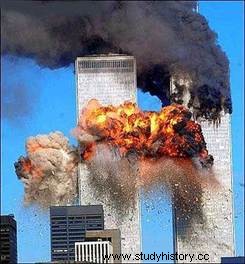 On September 11, 2001, the United States was hit by the greatest terrorist attack of all time. Two of the four civilian planes hijacked by Al-Qaeda Islamist terrorists target the two tallest skyscrapers on Manhattan Island, New York:the Twin Towers of the World Trade Center. Weakened by the violence of the impact and the spread of the fire, the two towers collapsed shortly afterwards, taking their occupants with them. In total, nearly 3,000 people (employees, visitors, relief and flight passengers) disappeared with the twin towers of the World Trade Center. The shock is global. A new war is opening against a new threat:terrorism.
On September 11, 2001, the United States was hit by the greatest terrorist attack of all time. Two of the four civilian planes hijacked by Al-Qaeda Islamist terrorists target the two tallest skyscrapers on Manhattan Island, New York:the Twin Towers of the World Trade Center. Weakened by the violence of the impact and the spread of the fire, the two towers collapsed shortly afterwards, taking their occupants with them. In total, nearly 3,000 people (employees, visitors, relief and flight passengers) disappeared with the twin towers of the World Trade Center. The shock is global. A new war is opening against a new threat:terrorism.
History of the long-lasting antagonism between two great powers, the cold war still today has harmful consequences on the balance of the world, such as on the treatment international terrorism. NATO's eastward extension of Europe has soured relations between Russia and the West, and the rise of China is giving rise to new political and economic tensions in a world that has become multipolar and still also uncertain.
To go further
- The Cold War:1943-1990, by Georges-Henri Soutou. Plural, 2011.
- The Cold War, by Catherine Durandin. Pocket PUF, 2019.
- Atlas of the Cold War:A global and multifaceted conflict. Editions Otherwise, 2017.
